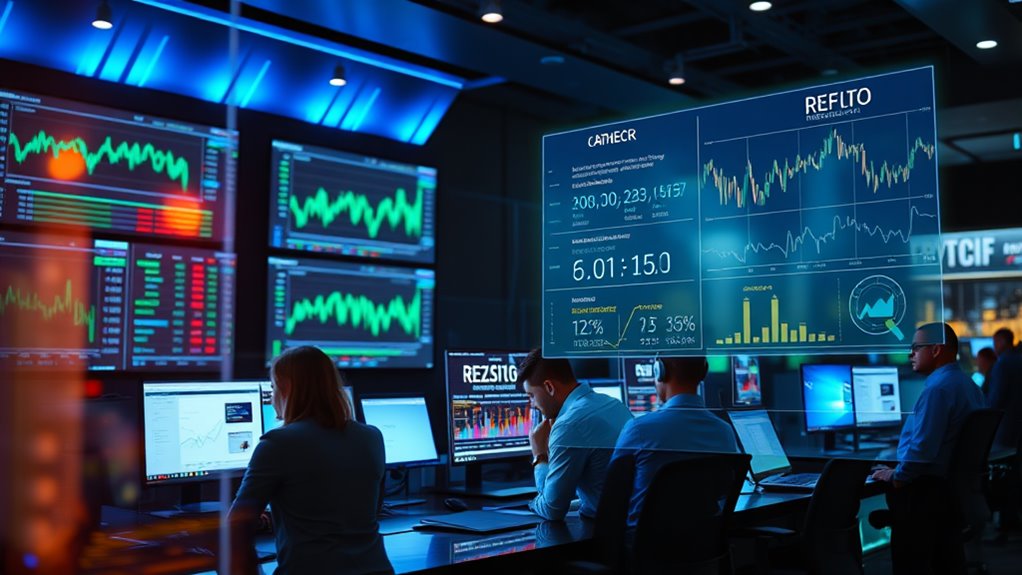
Future of Crypto Exchanges: Trends and Innovations Revealed
Cryptocurrency exchanges are evolving rapidly across multiple fronts. Market projections indicate robust growth, especially in emerging regions, while institutional investors increasingly view digital assets as legitimate portfolio components. AI-powered trading systems analyze market data in real-time, enhancing security through fraud detection and anti-manipulation measures. Meanwhile, tokenization of traditional assets, decentralized exchanges with cross-chain functionality, and DeFi integration represent significant innovations. Regulatory frameworks continue developing globally, with authorities balancing innovation against consumer protection. The following sections explore these transformative trends in greater detail.
Key Takeaways
- AI-powered trading systems analyze markets in real-time, enabling profitable strategies through pattern recognition and ideal price execution.
- Cryptocurrency exchange platforms are projected to grow from $37.23 billion in 2025 to $88.79 billion by 2033.
- Tokenization of traditional assets creates fractional ownership opportunities, with the market expected to reach $10 trillion by 2030.
- Cross-chain functionality connects isolated blockchain ecosystems, increasing liquidity and expanding trading opportunities across different networks.
- DeFi integration enhances user experience through staking and liquidity services, while hybrid solutions combine centralized security with decentralized transparency.
Global Expansion and the Rise of Institutional Investment

As cryptocurrency markets continue to mature, global expansion and institutional investment have emerged as key drivers of sustainable growth in the sector.
The global cryptocurrency exchange platform market is projected to grow from $37.23 billion in 2025 to $88.79 billion by 2033, representing an 11.2% CAGR.
The APAC region leads growth rates, while emerging markets in Southeast Asia, Latin America, and Africa are seeing increased adoption due to limited access to traditional banking.
Meanwhile, institutional investors are increasingly viewing digital assets as legitimate portfolio components, helping stabilize the market and drive innovation.
This institutional engagement is supported by clearer regulatory frameworks worldwide and technological advancements in blockchain and custody solutions, creating a more secure environment for large-scale investment. Additionally, the ongoing emphasis on consumer protection and anti-money laundering efforts reflects the commitment of regulators to foster a safe investment landscape.
AI-Powered Trading and Next-Generation Security Features

While traditional trading methods still dominate the crypto landscape, AI-powered solutions are rapidly transforming how exchanges operate and how traders interact with digital asset markets. These systems analyze vast quantities of market data in real-time, helping traders execute more profitable strategies through deep learning models and predictive analytics.
| AI Trading Benefits | Security Enhancement | User Experience |
|---|---|---|
| Real-time analysis | Fraud detection | Personalized interfaces |
| Reduced execution lag | Anti-manipulation | Risk-based recommendations |
| Pattern recognition | Smart contract auditing | Automated compliance |
| Ideal price execution | Quantum-resistant encryption | 24/7 support via chatbots |
Security remains paramount, with AI systems detecting market manipulation and preventing fraud through sophisticated anomaly detection. As quantum computing advances, exchanges are implementing resistant encryption protocols while continuously enhancing user experiences through customized interfaces and automated support. Understanding the risks associated with hacks is vital for ensuring the future integrity of these platforms.
Tokenization of Traditional Assets: The New Frontier

Beyond the AI-powered trading systems revolutionizing crypto exchanges, tokenization represents the next evolutionary step in digital asset markets. This process converts traditional assets like real estate, art, and stocks into blockchain-based digital tokens, enabling fractional ownership and enhanced liquidity.
The market for tokenized assets is projected to reach $10 trillion by 2030, driven by increasing institutional interest and evolving regulatory frameworks. Blockchain technology guarantees transparency and security, while smart contracts automate transactions and reduce intermediary costs.
Tokenization democratizes investment opportunities by lowering barriers for retail investors and allowing global access to previously restricted markets. Additionally, the rise of decentralized finance platforms is expected to further accelerate the adoption of tokenized assets, as they provide innovative ways to trade and leverage these digital tokens.
Tokenization breaks down investment walls, creating a worldwide financial playground accessible to everyday investors.
As interoperability between blockchain networks improves, the efficiency of tokenized asset trading will increase, creating new financial products that blend traditional and digital assets in previously impossible ways.
Decentralized Exchanges and Cross-Chain Functionality

The revolution in cryptocurrency trading has found its purest expression in decentralized exchanges (DEXs), where users trade directly with one another through blockchain-based protocols instead of relying on centralized intermediaries.
These platforms leverage smart contracts to execute trades automatically, enhancing security while reducing human error.
Cross-chain functionality has emerged as a critical innovation, connecting previously isolated blockchain ecosystems.
This development offers three significant benefits:
- Increased liquidity through the combination of multiple blockchain markets
- Expanded trading opportunities, including arbitrage across different networks
- Greater user flexibility to access diverse blockchain features and assets
Despite these advantages, challenges remain in cross-chain trading, particularly regarding security risks with wrapped tokens and bridge technologies.
As solutions evolve, DEXs continue moving toward a more interconnected, secure trading environment, with liquidity pools playing a vital role in facilitating smooth transactions across different platforms.
DeFi Integration and the Evolving Regulatory Landscape

As cryptocurrency exchanges evolve, the integration of decentralized finance (DeFi) has emerged as a natural expansion from traditional DEX functions. Centralized platforms like Binance Smart Chain now offer hybrid solutions, combining centralized security with DeFi transparency to enhance user experience through staking and liquidity services.
Meanwhile, regulatory frameworks are developing globally with significant variability. Authorities face the challenge of balancing innovation with consumer protection, as clearer regulations could potentially drive market growth by establishing trust. Recent developments, including the Trump administration’s efforts to provide regulatory clarity, signal a shift in the landscape that could influence the direction of exchanges.
Technological advancements in blockchain, AI, and cross-chain interoperability further support this integration, addressing critical security and scalability concerns.
The potential introduction of Central Bank Digital Currencies (CBDCs) adds another dimension, possibly coexisting with private cryptocurrencies while offering government-backed stability in an increasingly complex ecosystem.
Frequently Asked Questions
How Will Quantum Computing Affect Crypto Exchange Security Protocols?
Quantum computing threatens current cryptographic protocols by potentially breaking encryption, forcing exchanges to adopt post-quantum cryptography, implement quantum-resistant algorithms, and develop hybrid security models to protect assets and transaction integrity.
What Staffing Changes Will Exchanges Need for Expanding Financial Services?
Exchanges expanding financial services will need to hire financial analysts, compliance experts, and regulatory specialists. They may also require customer service staff with financial knowledge and technology integration specialists to manage new service platforms.
How Might Central Bank Digital Currencies Impact Private Cryptocurrency Exchanges?
Central bank digital currencies could challenge private exchanges by providing government-backed stability, potentially diverting users and trading volume. Exchanges may need to adapt their business models and offer complementary services to remain competitive.
When Will Crypto Carbon Footprints Become Standardized Metrics for Exchanges?
While carbon-conscious exchanges tout green credentials today, standardized crypto carbon metrics will likely emerge by 2025-2027 as regulatory pressures mount, voluntary frameworks mature, and market demand for verifiable environmental performance becomes impossible to ignore.
How Do Exchanges Plan to Address Digital Asset Inheritance Issues?
Exchanges are developing inheritance solutions including custodial services with beneficiary designations, multi-signature capabilities, and estate planning tools. They’re also collaborating with regulators to establish clear protocols for transferring digital assets after death.
Conclusion
As cryptocurrency exchanges evolve, they will continue blending innovative technology with traditional finance practices. From institutional adoption to asset tokenization and enhanced security measures, these platforms are positioning themselves at the intersection of accessibility and sophistication. Will these developments finally bridge the gap between conventional banking and the digital asset ecosystem? Only time will tell, but the trajectory points toward a more integrated, secure, and regulated future for crypto trading.












